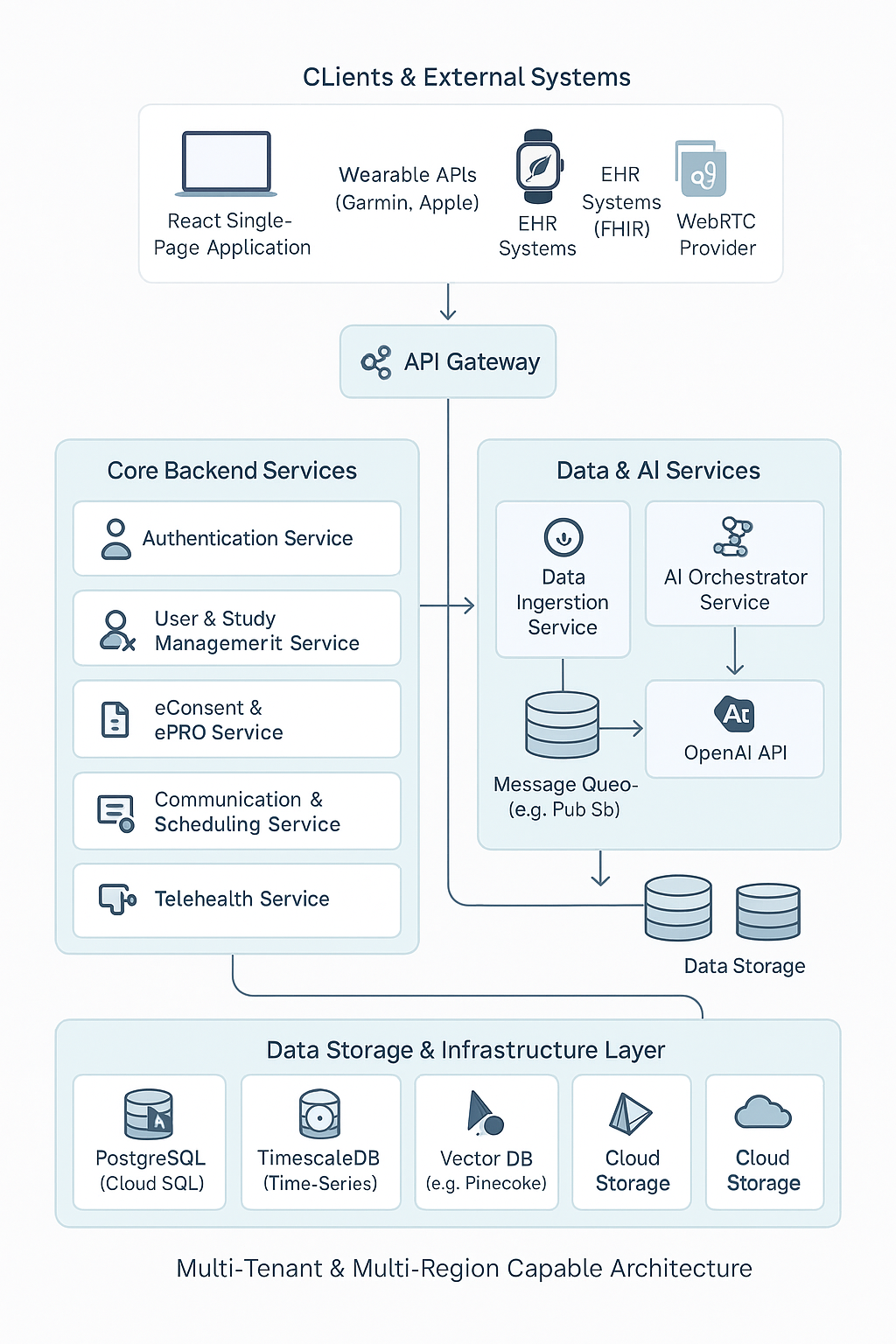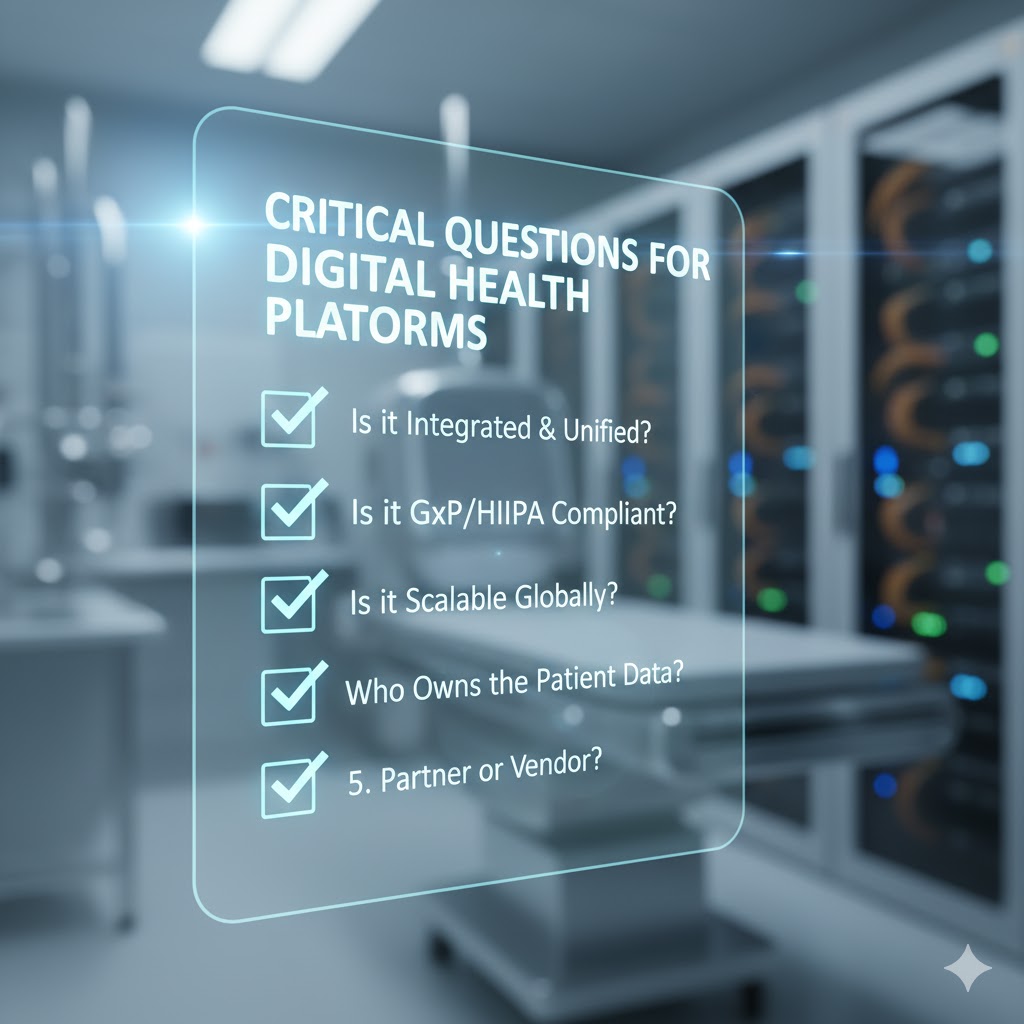The Clinical AI Flywheel: How Mahalo Health Is Reinventing Research
The Clinical AI Flywheel: A Blueprint for Modernizing Research with the Mahalo Platform
Abstract
The traditional clinical trial model is slow, expensive, and struggles to generate the rich, real-world data needed for modern medicine. Health organizations face significant barriers to implementing AI in a way that is safe, scalable, and compliant. The Mahalo platform is an end-to-end, multi-tenant digital health ecosystem designed to solve this challenge. It provides an integrated suite of tools for participant management, data ingestion, and advanced AI-driven care, all governed by a sophisticated MLOps and administrative framework. By unifying patient recruitment, AI-powered eCOA generation, and a human-in-the-loop AI health assistant, Mahalo creates a continuous improvement cycle—a "flywheel"—that accelerates trial timelines, enhances data quality, improves patient safety, and dramatically lowers the barrier to deploying clinical-grade AI.
1. The Crisis in Clinical Research: The "Old Way"
For decades, the clinical research paradigm has been defined by fragmentation and manual effort. Organizations grapple with a disconnected ecosystem of single-purpose tools, leading to profound inefficiencies:
- Siloed Data: Data from EHRs, patient diaries, and clinical assessments are stored in separate, incompatible systems, making holistic analysis nearly impossible.
- Manual Processes: Critical tasks like patient recruitment, consent management, and data monitoring are labor-intensive, reliant on paper or disconnected digital forms, and prone to human error.
- Limited Data Richness: Traditional methods capture only episodic snapshots of a patient's health during clinic visits, missing the continuous, real-world data that is crucial for understanding disease and treatment effects.
- High Costs & Long Timelines: This inefficiency translates directly into staggering costs and development timelines that can exceed a decade, delaying patient access to life-saving therapies.
This "old way" is not equipped for the era of AI and precision medicine. It lacks the foundational architecture needed to collect, manage, and leverage data at the scale and quality that sophisticated AI requires.
2. The Mahalo Platform: A New Paradigm for AI-Driven Research
The Mahalo platform is an integrated, cloud-native solution designed to replace this fragmented model. It provides a single, unified environment for conducting modern, decentralized clinical trials. The platform's "new way" is defined by three core principles: unification, automation, and intelligence.
At its core, Mahalo is a multi-tenant, multi-region, and multi-language platform, allowing global organizations to run multiple, fully isolated clinical studies from a single, centrally managed infrastructure.
2.1 Comprehensive Platform Architecture

The platform's power lies in its end-to-end architecture, which provides distinct, role-based interfaces for every stakeholder in a clinical trial.
- Foundation (Multi-Tenant & Multi-Region): The architecture is built on a multi-tenant model, where each "Organization" (e.g., a university, a pharmaceutical company) is a secure, isolated tenant. This is deployed across multiple geographic regions to comply with data residency laws like GDPR.
- Unified Data Engine: A single data pipeline ingests and harmonizes information from a vast array of sources:
- Wearables & Sensors: Continuous data from devices like Garmin watches and CGMs.
- EHR Integration: Secure, FHIR-compliant integration with clinical health records.
- ePRO & eConsent: Rich, structured data collected directly from participants.
- Role-Based Interfaces: The platform provides dedicated, secure web applications for every user: Participants, GPs, Study Coordinators, Researchers, and Platform Administrators.
3. Mahalo's Integrated AI Capabilities: From Recruitment to Analysis
Mahalo embeds AI across the entire clinical trial lifecycle, automating complex tasks and generating novel insights.
3.1 Patient Recruitment AI
Traditional patient recruitment is a major bottleneck. Mahalo's AI accelerates this process by intelligently matching patients to trials. Mahalo AI can analyze vast, de-identified datasets (both historical trial data and real-world data) to:
- Identify Eligible Cohorts: Build predictive models to identify patient populations that are most likely to be eligible for a study.
- Optimize Protocol Design: Simulate the impact of inclusion/exclusion criteria to prevent protocols that are too narrow and destined for recruitment failure.
3.2 Protocol Fit & eCOA Generation Agent
Building the data collection instruments for a trial is a time-consuming manual process. Mahalo introduces an Agentic AI to automate this. The tool can:
- Ingest a Protocol: A Study Coordinator uploads a clinical trial protocol document.
- Analyze Requirements: The AI agent parses the document, identifying all required patient outcomes and data collection points.
- Recommend & Generate eCOAs: The agent intelligently recommends the appropriate electronic Clinical Outcome Assessments (eCOAs) and ePRO surveys from its library of validated instruments. With a single click, it can auto-generate these surveys directly in the ePRO builder, complete with questions and branching logic. This reduces study setup time from weeks to hours.
3.3 HAIA: The Human-AI Health Assistant
Once a participant is enrolled, they interact with HAIA, a sophisticated conversational AI. It operates using a multi-agent architecture:
- Biomarker Agent: Accesses the participant's real-time wearable data.
- Knowledge Agent: Uses a Retrieval-Augmented Generation (RAG) pipeline to access a curated knowledge base of clinical guidelines.
- Core LLM Agent: Synthesizes this information to provide empathetic, personalized, and safe responses.
4. The MLOps & Governance Flywheel: Implementing AI the Sophisticated Way
The most significant innovation of the Mahalo platform is its Platform Administrator module, a comprehensive MLOps and governance suite that allows organizations to manage the entire AI lifecycle with rigor and safety. This creates a continuous improvement "flywheel."
This is how the Platform Administrator sets up and manages the "AI thingies" in a fully baked, end-to-end workflow:
- AI Model Registry: This is the central hub for all models (both LLMs and predictive models). The administrator can track every model version, its training data lineage, its performance metrics, and its current deployment status (
development,staging,production). - AI Testing & Evaluation: Before a new fine-tuned model is deployed, the administrator uses this suite to rigorously validate it. They can run the model against a "golden dataset" to check for regressions and use a human evaluation interface for clinical experts to perform side-by-side comparisons on safety and tone. This shifts quality control from a reactive to a proactive process.
- Controlled Deployment: Using the Model Registry, the administrator can safely promote a validated model to production or, if an issue is detected, instantly roll back to a previously stable version.
- AI Monitoring & A/B Testing: Once a model is live, this MLOps dashboard provides real-time monitoring of:
- Performance & Cost: API latency, token usage, and cost per interaction.
- Drift Detection: Alerts the administrator if the model's performance is degrading over time.
- A/B Testing: Allows the administrator to route a small percentage of live traffic to a new candidate model to gather real-world performance data before a full rollout.
- Automated Retraining: The administrator can schedule automated jobs to retrain and fine-tune models as new data—such as the expert-corrected responses from the GP's
Supervision Queue—becomes available.
This flywheel ensures that the AI models are not static but are continuously improving in a safe, auditable, and data-driven manner.
5. Tangible Outcomes: From the "Old Way" to the "New Way"
Conclusion
Implementing AI in clinical research is not merely about having a chatbot; it's about building an integrated, end-to-end ecosystem that manages the entire lifecycle of data and intelligence. The Mahalo platform provides this ecosystem. By combining a robust, multi-tenant foundation with a sophisticated MLOps and governance flywheel, it empowers health organizations to move beyond the fragmented "old way" and embrace a future of faster, safer, and more insightful clinical research.


.jpg)


